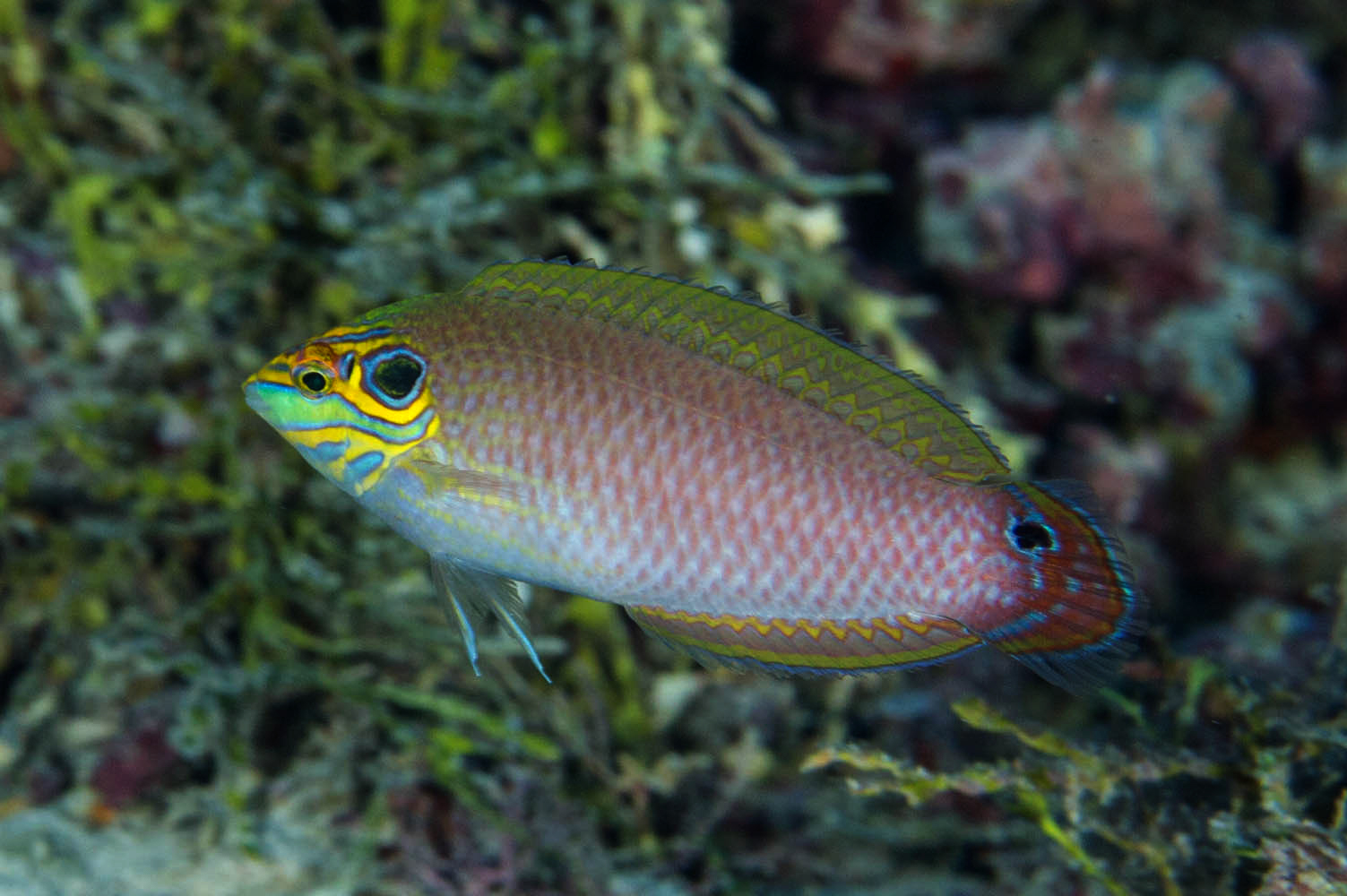- Classification
- ACTINOPTERYGII
- PERCIFORMES
- LABRIDAE
- Halichoeres
- melasmapomus
Earmuff Wrasse, Halichoeres melasmapomus Randall 1981
Other Names: Black-eared Wrasse, Cheekspot Wrasse, Ocellated Wrasse

A female Earmuff Wrasse, Halichoeres melasmapomus, at Marovo Island, Solomon Islands, November 2014. Source: Mark Rosenstein / iNaturalist.org. License: CC BY Attribution-Noncommercial-ShareAlike
Summary:
A distinctive wrasse with a large pale-edged black spot on the gill cover. Males (terminal phase) are lavender with a darker marking on each scale, a large blue-edged black spot behind the eye, yellow-orange bands on the head, and a red caudal fin. The similar females (initial phase) have 2-3 pale-edged black spots along the dorsal fin, and a large pale-edged black spot on the caudal fin.
Cite this page as:
Bray, D.J. 2020, Halichoeres melasmapomus in Fishes of Australia, accessed 02 Jul 2025, https://fishesofaustralia.net.au/Home/species/2293
Earmuff Wrasse, Halichoeres melasmapomus Randall 1981
More Info
|
Distribution |
Rowley Shoals, Western Australia, the northern Great Barrier Reef, Queensland, and reefs in the Coral Sea; also at Christmas Island and Cocos (Keeling) Islands in the eastern Indian Ocean. Elsewhere, the species occurs in the east-Indo-west-central Pacific. Inhabits deeper reefs, on rubble and mixed coral/rubble patches often along steep drop-offs. The species is rare in shallow waters. |
|
Features |
Dorsal fin IX, 12; Anal fin III, 12; Pectoral fin 13; Principal caudal rays 14 (middle 12 branched); Gill rakers 14-18; Lateral line scales 27; Vertebrae 25. Anterior lateral line scales with 2-7 pores, more in larger adults; 9-13 suborbital pores. Pelvic fins reaching or nearly reaching anus in large adults. |
|
Etymology |
The specific name melasmapomus is from the Greek in reference to the large black spot on the opercle, the most characteristic color marking at all stages. |
|
Species Citation |
Halichoeres melasmapomus Randall 1981, Pacific Science 34(4): 421, figs 3-4. Type locality: Pitcairn Island, reef on north side off Gannet Ridge, 40-44 m. |
|
Author |
Bray, D.J. 2020 |
|
Resources |
Earmuff Wrasse, Halichoeres melasmapomus Randall 1981
References
Allen, G.R. 1993. Fishes of Ashmore Reef and Cartier Island. Records of the Western Australian Museum, Supplement 44: 67-91
Allen, G.R. 1997. Marine Fishes of Tropical Australia and South-east Asia. Perth : Western Australian Museum 292 pp. 106 pls.
Allen, G.R. & Erdmann, M.V. 2012. Reef fishes of the East Indies. Perth : Tropical Reef Research 3 vols, 1260 pp.
Allen, G.R. & Russell, B.C. 1986. Part VII Fishes. pp. 79-103 in Berry, P.F. (ed.) Faunal Surveys of the Rowley Shoals, Scott Reef and Seringapatam Reef, northwestern Australia. Records of the Western Australian Museum, Supplement 25: 1-106
Allen, G.R. & Smith-Vaniz, W.F. 1994. Fishes of Cocos (Keeling) Islands. Atoll Research Bulletin 412: 1-21
Allen, G.R. & Steene, R.C. 1979. The Fishes of Christmas Island, Indian Ocean. Aust. Natl. Parks Wldlf. Ser. Spec. Publ. 2. Canberra : Australian Government Publishing Service 81 pp. 15 pls.
Allen, G.R. & Steene, R.C. 1988. Fishes of Christmas Island Indian Ocean. Christmas Island : Christmas Island Natural History Association 197 pp.
Allen, G.R., Steene, R.C. & Orchard, M. 2007. Fishes of Christmas Island. Christmas Island : Christmas Island Natural History Association 2 edn, 284 pp.
Barber, P.H. & Bellwood, D.R. 2005. Biodiversity hotspots: evolutionary origins of biodiversity in wrasses (Halichoeres: Labridae) in the Indo-Pacific and new world tropics. Molecular Phylogenetics and Evolution 35: 235-253 https://doi.org/10.1016/j.ympev.2004.10.004
Choat, J.H. 2010. Halichoeres melasmapomus . The IUCN Red List of Threatened Species 2010: e.T187564A8569710. https://dx.doi.org/10.2305/IUCN.UK.2010-4.RLTS.T187564A8569710.en. Downloaded on 03 March 2020.
Hobbs, J-P.A., Newman, S.J., Mitsopoulos, G.E.A., Travers, M.J., Skepper, C.L., Gilligan, J.J., Allen, G.R., Choat, H.J. & Ayling, A.M. 2014. Checklist and new records of Christmas Island fishes: the influence of isolation, biogeography and habitat availability on species abundance and community composition. Raffles Bulletin of Zoology Supplement 30: 184–202
Hobbs, J-P.A., Newman, S .J., Mitsopoulos, G.E.A., Travers, M.J., Skepper, C.L., Gilligan, J.J., Allen, G.R., Choat, H.J. & Ayling, A.M. 2014. Fishes of the Cocos (Keeling) Islands: new records, community composition and biogeographic significance. Raffles Bulletin of Zoology Supplement 30: 203–219
Hutchins, J.B. 2001. Biodiversity of shallow reef fish assemblages in Western Australia using a rapid censusing technique. Records of the Western Australian Museum 20: 247-270
Kuiter, R.H. 2002. Fairy & Rainbow Wrasses and their Relatives. Chorleywood, U.K. : TMC Publishing 207 pp. (as Halichoeres xanti, in part, as senior synonym of Halichoeres melasmapomus)
Kuiter, R.H. 2010. Labridae fishes: wrasses. Seaford, Victoria, Australia : Aquatic Photographics pp. 398. (as Biochoeres xanti, in part, as senior synonym of Halichoeres melasmapomus)
Moore, G.I., Morrison, S.M., Hutchins, J.B., Allen, G.R. & Sampey, A. 2014. Kimberley marine biota. Historical data: fishes. Records of the Western Australian Museum, Supplement 84: 161-206
Randall, J.E. 1981. Two new Indo-Pacific labrid fishes of the genus Halichoeres with notes on other species of the genus. Pacific Science 34(4): 415-432 figs 1-16 http://hdl.handle.net/10125/1640, open access
Randall, J.E. 2005. Reef and shore fishes of the South Pacific. New Caledonia to Tahiti and the Pitcairn Islands. Honolulu : University of Hawaii Press 707 pp.
Randall, J.E., Allen, G.R. & Steene, R. 1990. Fishes of the Great Barrier Reef and Coral Sea. Bathurst : Crawford House Press 507 pp. figs.
Randall, J.E., Allen, G.R. & Steene, R. 1997. Fishes of the Great Barrier Reef and Coral Sea. Bathurst : Crawford House Press 557 pp. figs.
Westneat, M.W. 2001. Labridae. pp. 3381-3467 in Carpenter, K.E. & Niem, T.H. (eds). The Living Marine Resources of the Western Central Pacific. FAO Species Identification Guide for Fisheries Purposes. Rome : FAO Vol. 6 pp. 3381-4218.






